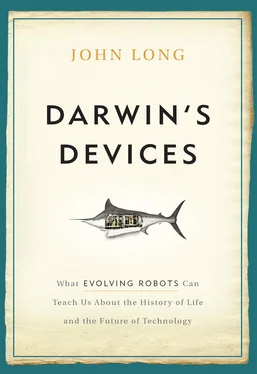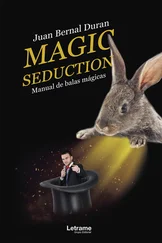Carew, again. Ibid.
I really hate the use of the word “simple” in a context like this because it comes packed with so much anthropocentric baggage. One item in our luggage is that we humans assume that we are the most “complex” organisms by any measure. But consider a single-celled organism: in one cell it packs all the basic functions—like eating, moving, and reproducing—that we humans need a multicellular body to perform. As we go on, you’ll see that I call Tadro3 “simple” with specific reference to its sensory-motor system. That’s okay, I’d argue, because I’m being explicit about the system of comparison. Implicit “simplicity” means a thousand different, unspoken things.
Lakoff and Johnson, Philosophy in the Flesh .
George Lakoff, “The Neural Theory of Metaphor,” in Gibbs, The Cambridge Handbook of Metaphor and Thought , 17–38.
Louise Barrett, Beyond the Brain: How Body and Environment Shape Human Minds (Princeton, NJ: Princeton University Press, 2011).
Neurocomputational modeling of swimming vertebrates by Örjan Ekeberg and then Auke Ijspeert have shown that many, many possible circuit structures will produce the same function (functionalism rules!). Thus, we shouldn’t take the two T3 circuits here as the only ones that are possible. Örjan Ekeberg, “A Combined Neuronal and Mechanical Model of Fish Swimming,” Biological Cybernetics 69, nos. 5–6 (1993): 363–374. Auke Jan Ijspeert, John Hallam, and David Willshaw, “Evolving Swimming Controllers for a Simulated Lamprey with Inspiration from Neurobiology,” Adaptive Behavior 7, pt. 2 (1999): 151–172.
Valentino Braitenberg, Vehicles: Experiments in Synthetic Psychology (Cambridge, MA: MIT Press, 1984), 20.
Ibid.
Brooks chronicles this revolution: Rodney A. Brooks, Flesh and Machines: How Robots Will Change Us (New York: Pantheon Books, 2002).
For more on Brooks’s Ghenghis, including its ancestors and descendants, dig around at the website of the MIT Computer Science and Artificial Intelligence Laboratory: www.csail.mit.edu/.
Behavior-based robotics, as a field, was codified by Professor Ronald Arkin in his seminal textbook, Behavior-Based Robotics (Cambridge, MA: MIT Press, 1998). Behavior-based robotics is now recognized as one of the first successful forays into the general field of biologically inspired artificial intelligence. For more, see Dario Floreano and Claudio Mattiussi, Bio-Inspired Artificial Intelligence: Theories, Methods, and Technologies. (Cambridge, MA: MIT Press, 2008).
Rodney Brooks, “A Robust Layered Control System for a Mobile Robot,” A.I. Memo 864, MIT Artificial Intelligence Laboratory, 1985. Published as R. Brooks, “A Robust Layered Control System for a Mobile Robot,” IEEE Journal of Robotics and Automation 2, no. 1 (1986): 14–23.
Matt McHenry, whom you may remember as one of the inventors of Tadro1, and his PhD student, William Stewart, combined experiments on and models of zebrafish to look at the possible influence of a predator on flow around a prey: W. J. Stewart, and M. J. McHenry, “Sensing the Strike of a Predatory Fish Depends on the Specific Gravity of a Prey Fish,” The Journal of Experimental Biology 213, pt. 22 (November 2010): 3769–3777.
For a review of fast starts in the context of predatory-prey situations, read: P. Domenici, “Scaling of Locomotor Performance in Predatory-Prey Encounters: From Fish to Killer Whales,” Comparative Biochemistry and Physiology Part A 131 (2001): 169–182.
This figure of 3 G during takeoff is from mission specialist Koichi Wakata and can be found at the NASA website: \spaceflight.nasa.gov/feedback/expert/answer/crew/sts-92/index.html.
For a lovely review of this fast-start escape circuit, see the following papers: S. J. Zottoli and D. S. Faber, “The Mauthner Cell: What Has It Taught Us?” The Neuroscientist 6, no. 1 (2000): 26–38; R. C. Eaton, R. K. K. Lee, and M. B. Foreman, “The Mauthner Cell and Other Identified Neurons of the Brainstem Escape Response Network,” Progress in Neurobiology 63 (2001): 467–485. Also, excellent experiments on the variety of ways that fish use their reticulospinal circuits for escape and predation have been conducted by Melina Hale, associate professor of organismal biology and anatomy, University of Chicago.
My favorite paper of Fetcho’s on the control of swimming behaviors is K. R. Svoboda and J. R. Fetcho, “Interactions Between the Neural Networks for Escape and Swimming in Goldfish,” Journal of Neuroscience 16, no. 2 (1996): 843–852.
From an interview by New York Times reporter Adam Bryant, “Don’t Lose That Start-Up State of Mind,” October 16, 2010, http://www.nytimes.com/2010/10/17/business/17corner.html?_r=1&ref=adam_bryant.
I encourage you to explore Full’s excellent website: http://polypedal.berkeley.edu/cgi-bin/twiki/view/PolyPEDAL/WebHome.
A reference to Ferengi first officer Kazako from “The Battle,” an episode of Star Trek: The Next Generation (first season).
I’ve tried to address this line of criticism in more detail by placing Tadro and the Tadro evolutionary system in the explicit context of Webb’s system: J. H. Long, “Biomimetic Robotics: Building Autonomous, Physical Models to Test Biological Hypotheses,” Proceedings of the Institution of Mechanical Engineers, Part C, Journal of Mechanical Engineering Science 221 (2007): 1193–1200.
Strictly speaking, Rob’s observation is a logical inference based on the following reasoning: post hoc ergo proctor hoc (after this therefore because of this). In this case, because the three paired sense organs evolved before vertebrae did, then the evolution of vertebrae must be contingent upon those sense organs and the functional capacities that they bring to the vertebrates. We can test this assertion using the new Tadro4 system. Without such a test, by the way, the assertion does not stand on its own accord because many other changes in vertebrates occurred along with the changes in the sense organs.
An open-source physics engine that may be used for simulation of rigid-body dynamics is ODE: www.ode.org/. Unfortunately, this physics engine along with most others does not model the interactions of flexible bodies and fluids. That’s because the physics are very complicated. Thus, we’ve been building and modifying our own physics engine.
If you are interested in Tom’s approach, try: Thomas Ellman, Ryan Deak, and Jason Fotinatos, “Automated Synthesis of Numerical Programs for Simulation of Rigid Mechanical Systems in Physics-Based Animation,” Automated Software Engineering 10, no. 4 (2003): 367–398.
The traits that the engineer allows to vary, just like we allowed traits to vary in our Tadro3, defines the design space. The hill, then, is the combination of those traits that gives the best performance compared to other combinations. Engineers use genetic algorithms instead of doing exhaustive searches of all possible combinations of traits; if you have many traits or features you need to consider, using a genetic algorithm can help you find the hill faster because you don’t rely on your intuition to find the optimum (as defined by a position in multiple dimensions, e.g., the optimal design has a specific weight, drag coefficient, and gear ratio).
Читать дальше












